The new Ancient Egypt and Nubia Galleries at the Ashmolean, Oxford
Although by its status it belongs to the University of Oxford, the Ashmolean Museum proudly claims to be the oldest public museum in the United Kingdom and, indeed, one of the earliest in the world. The Old Ashmolean, now the Museum of the History of Science in Broad Street, was inaugurated in 1683. The present Ashmolean, in Beaumont Street, opposite the
Randolph Hotel, was designed in a neo-classical style by the prominent English architect and antiquarian Charles Robert
Cockerell (1788-1863). It opened its doors to visitors in 1845 and three years later, in 1848, it was followed by another of Cockerell’s designs, the Fitzwilliam Museum in Cambridge. While the exterior of the building remained largely intact, minor architectural alterations of the interior of the Ashmolean were carried out during the next one and a half centuries. These were due to temporary needs and ad hoc decisions, such as the celebrated royal loo which was hastily constructed in anticipation of a royal visit and which, as it turned out, was eventually not needed. The result was an eclectic assemblage of rooms of different shapes and sizes, often on slightly different levels so that they had to be approached by steps up or down from the adjoining areas and sometimes interconnected by narrow and winding passages. Several modern galleries were added in the process, including a new installation of the Egyptian room with the Min colossi. But such a piecemeal approach was not satisfactory for a modern museum although it lent the Ashmolean a special charm and feeling of bygone days.
A major re-design of the interior of the Museum by the architect Rick Mather created, at the cost of £61 million, 39 new galleries and was completed at the end of 2009. The design had to respect the original Cockerell exterior and was universally praised as a great success, even though some reservations were expressed about the thematic approach to the arrangement of some of the displays where it was felt that the Museum may have tried to punch above its weight. But the Egyptian galleries were left untouched because of the lack of finances.
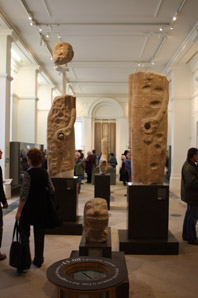
This unsatisfactory situation has now been resolved and the new Ancient Egypt and Nubia Galleries opened at the end of November 2011. The same architect, Rick Mather, was responsible for the design while the displays were arranged by the new Assistant Keeper for Ancient Egypt and Sudan, Dr Liam McNamara. Practically all funding came from outside sources, with Lord Sainsbury of Preston Candover, KG, being the largest benefactor. Ancient Egypt and Nubia now has six rooms, Ashmolean galleries 22 to 27. The space has been substantially enlarged by incorporating the Ashmolean’s west wing which had undergone several radical changes in the past, the last two being a lecture room and then the Museum’s shop. Now, as No. 22, The Lisa and Bernard Selz Gallery, it houses the display on Egypt and its Origins. Gallery No. 23, The Christian Levett Family Gallery, is devoted to Dynastic Egypt and Nubia, while No. 24, The Sackler Gallery, is on Life and Death in Ancient Egypt. No. 25 is, in the good old Oxford tradition cautiously named, The Amarna ‘Revolution’, No. 26 is Egypt in the Age of Empires, and in No. 27, Egypt meets Greece and Rome. The approach is, therefore, traditionally chronological and not startlingly surprising. Only Nos. 24 and 27 diverge from it and one is left wondering whether this reflects the riches of the collection or represents a concession to the public taste for whom funereal paraphernalia represent the essence of ancient Egypt.
Gallery 22 has most of the pieces for which the Ashmolean is famous, principally from Flinders Petrie’s excavations at Qift (Coptos) and Quibell and Green’s work at Kom el-Ahmar (Hieraconpolis). The Min colossi have lost their masculine attributes but remain impressive and authoritatively dominate the space. There are the usual suspects, the MacGregor Man, the Scorpion macehead, the Two Dogs Palette and the Khasekhem statue. But I was taken by the less than life-size statue of a lion from Coptos, now for the first time displayed to its best advantage. How is it possible that this highly stylized, partly almost abstract, sculpture existed side by side with such realistic representations of lions as on the so-called Battlefield Palette from Abydos? Perhaps one’s first assumption that realism must precede abstraction is simplistically naive. I was pleased to see panels on Animals in early art and on Petrie’s seriation system, the first a nod in the direction of synthesis rather than just display, the other a hint that this is, after all, a university museum.
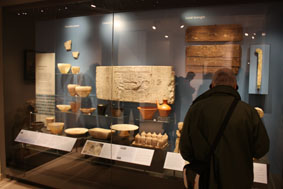
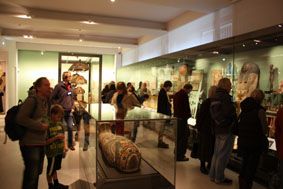
Gallery 23 demonstrates best what I see as the two main advances compared with the previous Ashmolean display. Firstly, Liam MacNamara has successfuly resisted the temptation to fill all available space and the larger monuments can now be walked round and be seen from all sides. This is important and I shall test this when we take our friend who is confined to a wheelchair to see Ancient Egypt and Nubia in the Ashmolean next week. Secondly, the galleries are well-lit and gone is the notion that anything connected with ancient Egypt must be arcanely murky and dark. The shrine of Taharqa from Kawa is the focal point of this room. The small panel on the work of the outstanding epigraphist Nina de Garis Davies is most welcome although I feel that Norman de Garis Davies has been hard done by being described (or do I mean dismissed?) as a mere Egyptologist. He was, after all, as good an epigraphist as his wife. A video accompanies a similar feature on Francis Llewellyn Griffith, the first Professor of Egyptology at Oxford, and is one of the few attempts to go beyond the display&label approach. There are audio guides but, as warned by a notice, these are not yet up to date. I can’t say that this worries me too much. On the whole, I do not like my museum visits to be pre-digested but that may just show my age. Nevertheless, somewhat disappointingly, the possibilities offered by modern information technology have been left almost completely unexploited. So there you are, kids, if that is what you want, go back to your play stations and computer games!
The focus of Gallery 24 is the set of coffins of Djedjehutefankh, of the 25th Dynasty, from Deir el-Bahri. Egyptologists may be somewhat dismissive of the bunk-bed way of displaying sets of coffins as an easy gimmick but it probably is the best way of showing how the multiplicity of sarcophagi, coffins, cartonnages and mummy boards worked. It is good to see the splendid papyrus with the will of Naunakhte, of the year 3 of Ramesses V, and the Adoption Papyrus of the reign of Ramesses XI.
Amarna monuments in Gallery 25 represent, together with the Early Dynastic material, one of the greatest strengths of the Ashmolean collection. The Amarna Princesses are shown in such a way that one is left in no doubt that this is only a relatively small part of what used to be a large wall painting. These days it is necessary to stress that this detail was not cut out from a complete scene, it was the only part which was preserved. The labels misleadingly refer to it as a fresco, perhaps just to test the knowledge of visitors. It is good to see that headless Nefertiti from the British Museum was allowed to join her equally headless husband Akhenaten, and that they now stand side by side as they did in the garden shrine of Amarna house L.50.9. And I just love the relief with Nefertiti offering a bouquet of flowers to the now absent sun disk.
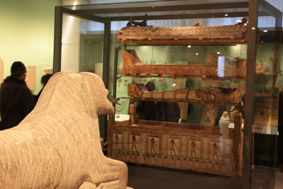
One would be forgiven if one believed that the intercourse with Greece and Rome in Gallery 27 was mainly between mummies. There is an excellent example of a mummy of the Roman Period with the portrait still in attached, thus demonstrating the use of the so-called Faiyum portraits. But the most fascinating item is not ancient: a three-dimensional image of a child mummy consisting of ink drawings on 111 sheets of glass and based on CT scans made at the John Radcliffe Hospital in Oxford. The image was created by Angela Palmer and is a wonderful example of how it is possible to find a meeting place between ancient and modern.
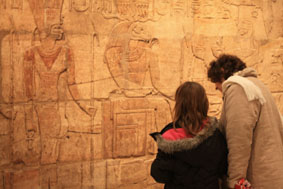
Everybody involved in the preparation of The Ancient Egypt and Nubia Galleries at the Ashmolean worked incredibly hard to get the display ready for a very tight deadline. They have delivered on time and the large number of visitors packing the rooms prove that they have been successful. A distinguished collection of Egyptian antiquities has at last received a display it deserves.
(Jaromir Malek)
Opening hours of the Museum: Tuesday-Sunday and Bank Holiday Mondays: 10.00 - 18.00. Admission free. Ashmolean website: http://www.ashmolean.org